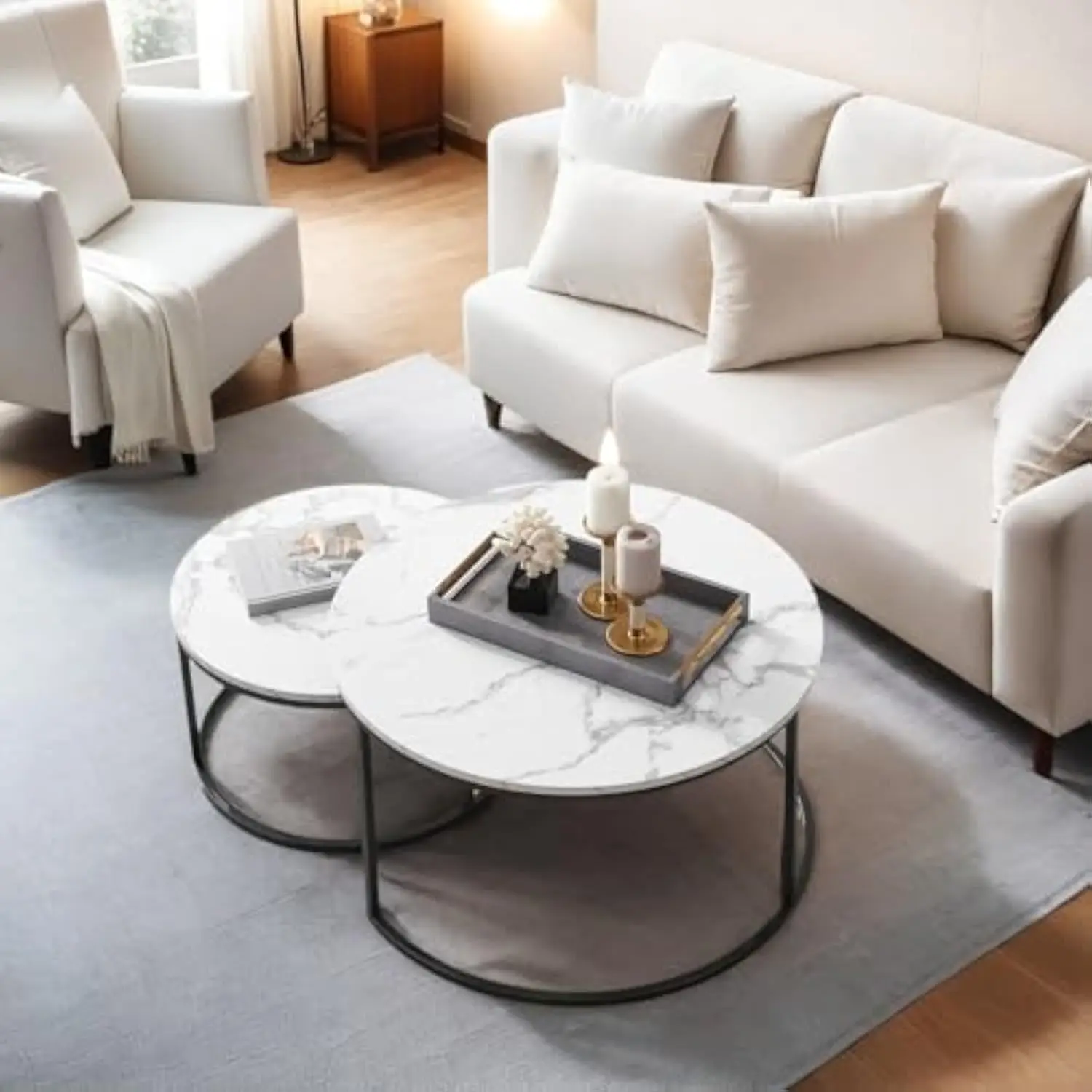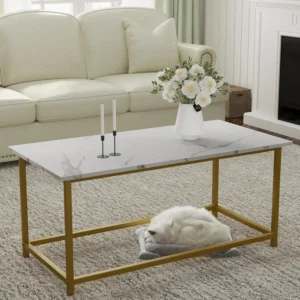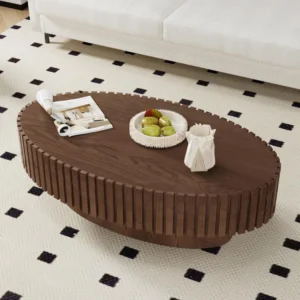Introduction: The Enduring Appeal of Round Mid-Century Coffee Tables
The mid-century modern design movement, which flourished from the 1940s through the 1960s, continues to captivate interior design enthusiasts today. This enduring style emphasizes clean lines, organic forms, and the perfect balance between beauty and functionality. At the heart of many mid-century inspired living spaces sits a distinctive piece that embodies these principles: the round coffee table.
Round mid-century coffee tables represent the essence of this design philosophy—combining practical utility with aesthetic appeal in a way that feels both nostalgic and remarkably current. Their fluid shapes and characteristic elements make them not just furniture pieces, but conversational focal points that anchor living spaces with distinctive character.
While rectangular tables often dominate furniture showrooms, round mid-century coffee tables offer unique advantages worth exploring. Their curved silhouettes provide both visual and practical benefits that have kept them relevant across decades of changing design trends. Understanding these intelligent black mid-century coffee tables and their distinctive features helps appreciate why they remain design staples.
At Hearth Forms, we celebrate these iconic pieces, recognizing how their authentic design principles—organic curves, quality materials, and thoughtful craftsmanship—continue to elevate modern interiors with their timeless charm.
The Functional Advantages of Round Coffee Tables
The appeal of round coffee tables extends far beyond their aesthetic qualities, offering several practical benefits that enhance both comfort and functionality in living spaces.
Safety First: No Sharp Corners
One of the most significant advantages of round coffee tables is their inherent safety. Without sharp corners or edges, they minimize the risk of injuries, particularly in homes with young children or elderly individuals. The smooth, continuous edge eliminates those painful encounters with table corners that can result in bruises or more serious injuries.
Optimizing Space and Flow
Round coffee tables can make smaller living areas feel more spacious and improve traffic flow throughout the room. Their circular footprint allows for easier navigation around them, creating more natural pathways through your living space. Unlike rectangular tables that can disrupt the flow of movement, round tables let people move more freely around seating arrangements.
Most mid-century modern round coffee tables require approximately 12 inches of clearance on all sides, creating a more efficient use of floor space while maintaining accessibility from any angle.
Adaptable Placement Options
The absence of corners makes round tables remarkably versatile when it comes to placement. They can be positioned in various locations within a room without creating awkward angles or obstructions. This flexibility is particularly valuable in apartments or smaller homes where furniture arrangement options might be limited.
Enhancing Social Interaction
Perhaps one of the most appealing functional uses round mid-century tables offer is their natural ability to facilitate conversation and interaction. The circular shape allows everyone seated around it to see and engage with one another more easily, creating a more inclusive social environment. Without corners or “head” positions, round tables promote a sense of equality and openness in conversations.
This social-friendly design aligns perfectly with mid-century modern philosophy, which prioritized creating spaces that encouraged human connection and interaction.
Key Elements of Mid-Century Modern Coffee Table Design
Mid-century modern coffee tables are distinguished by several characteristic design elements that make them immediately recognizable even to casual observers. Understanding these features helps appreciate what makes an authentic piece truly special.
Clean, Organic Lines
Mid-century design masterfully balances geometric precision with natural, organic forms. Round coffee tables exemplify this principle with their perfect circular tops supported by thoughtfully designed bases. The resulting aesthetic feels both mathematically precise and naturally flowing.
Material Authenticity
The mid-century movement embraced honest materials, with wood being particularly celebrated. Mid-century modern solid wood coffee tables typically feature:
- Walnut: Prized for its rich, dark tones and distinctive grain patterns
- Teak: Valued for its warmth, durability, and resistance to moisture
- Oak: Appreciated for its strength, visible grain, and light honey tones
These woods weren’t merely hidden structural elements but celebrated features, often finished to highlight their natural beauty and unique grain patterns.
Distinctive Leg Styles
The legs of mid-century coffee tables are often their most recognizable feature, with several iconic styles:
- Splayed legs: Angled outward to provide stable support while creating a sense of dynamic energy
- Pencil legs: Thin, straight supports that offer visual lightness and an almost floating appearance
- Hairpin legs: Minimalist metal supports that maximize floor visibility and enhance spatial flow
These leg designs create the characteristic “floating” effect that gives mid-century furniture its distinctive visual lightness despite often being crafted from substantial materials.
Craftsmanship Details
Quality mid-century pieces showcase exceptional attention to detail through:
– Precise joinery techniques that minimize visible hardware
– Thoughtfully designed edge profiles that enhance the tactile experience
– Hand-applied finishes that protect while highlighting natural materials
Material Integration
While wood forms the foundation of many mid-century tables, designers often incorporated complementary materials:
– Glass tops for visual lightness and practical durability
– Metal accents adding structural integrity and visual contrast
– Stone elements bringing textural interest and natural variety
These thoughtful combinations created pieces that were visually interesting without being ornate or overdone.
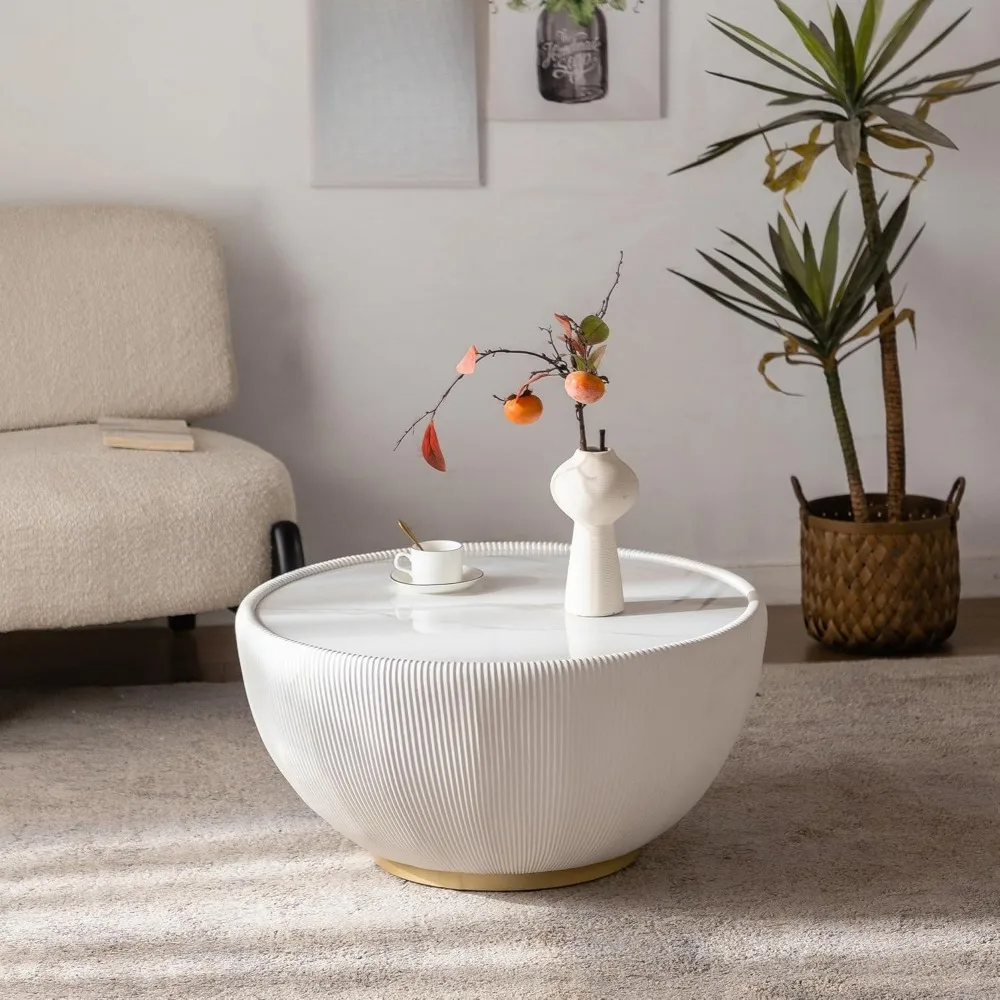
Visual Impact: How Round Mid-Century Tables Transform a Space
The introduction of a round mid-century coffee table can dramatically transform a living space in several key ways that interior designers consistently recognize.
Balance and Contrast
Round tables excel at softening rooms dominated by angular furniture and architectural elements. In spaces with rectangular sofas, square chairs, and linear architectural details, a round table introduces a welcome visual contrast. This juxtaposition of shapes creates a more dynamic, visually interesting environment while preventing the space from feeling rigid or severe.
The defining aesthetic features round mid-century tables possess allow them to break up visual monotony while maintaining design cohesion through shared materials and stylistic elements.
Creating a Focal Point
Round coffee tables naturally draw the eye, serving as anchors in conversational groupings. Their symmetrical shape creates a sense of balance and harmony, establishing a central point around which other furniture can be arranged. This organizing principle helps bring order to even eclectic design schemes.
Visual Lightness
The typical elevated profile of mid-century tables—often standing on slender legs—creates valuable negative space beneath the table surface. This openness allows light to flow through the room more freely and prevents the table from feeling heavy or obstructive, making the entire space feel more open and airy.
Versatile Design Integration
One of the most remarkable qualities of round mid-century tables is their chameleon-like ability to complement various design aesthetics. While they pair naturally with other mid-century pieces, they also work beautifully alongside:
- Contemporary minimalist furniture
- Traditional upholstered pieces
- Industrial-inspired elements
- Bohemian textiles and accessories
This versatility stems from their clean lines and organic forms, which create dialogue with many different design languages. Black mid-century coffee table design elements, for instance, can add dramatic contrast in lighter spaces or blend seamlessly with other dark furniture pieces.
Scale Considerations
When selecting a round coffee table, proper scaling is crucial. Generally, the ideal diameter ranges from 30 to 48 inches, depending on your seating arrangement. For optimal proportion, aim for a table diameter approximately two-thirds the length of your sofa, creating visual balance without overwhelming the space.
Styling Your Round Mid-Century Coffee Table: Design Principles
Creating an eye-catching yet functional coffee table display requires understanding a few key design principles that complement the mid-century aesthetic.
The Power of Balance
Effective coffee table styling begins with balance—both symmetrical and asymmetrical. With round tables, symmetrical arrangements work well when viewed from a primary seating position, while asymmetrical groupings can create more dynamic visual interest from multiple angles. Either approach requires thoughtful consideration of the objects’ visual weight, height, and positioning.
The Rule of Three
One of the most reliable styling formulas involves grouping objects in threes—this creates visual harmony while avoiding the monotony of even numbers. A classic arrangement might include:
- A stack of interesting books or magazines
- An organic element (plant, wooden object, or stone)
- A decorative object with personal significance
This combination provides varying heights, textures, and functions while maintaining a cohesive look that doesn’t overwhelm the table surface.
Height and Scale Considerations
When styling black mid-century coffee table surfaces, varying heights creates visual interest and dimension. However, keep decorative items proportional to the table—nothing should be so tall that it blocks conversation or television viewing. Generally, the tallest item should not exceed 12 inches in height for most living room arrangements.
Texture and Material Mixing
Incorporating different textures and materials adds depth and interest to your coffee table display. Consider combining:
- Smooth surfaces (glass, polished ceramics)
- Natural fibers (woven baskets, wooden objects)
- Metallic elements (brass objects, sculptural pieces)
- Soft textiles (small fabric-covered boxes, coasters)
This textural variety creates a more sophisticated, layered look that complements the mid-century aesthetic’s appreciation for material contrast.
Embracing Negative Space
Perhaps the most important styling principle for mid-century pieces is respecting negative space. Resist the urge to overcrowd the table—the clean lines and beautiful form of a quality mid-century table deserve to be seen and appreciated. Aim to leave approximately 50% of the surface visible to maintain the clean, uncluttered aesthetic that defines mid-century design.
Functional Styling
Remember that coffee tables need to remain functional. Create small vignettes while leaving space for practical use—setting down drinks, remotes, or books. Consider using a small decorative tray to corral smaller items, making it easy to move them aside when more surface area is needed.
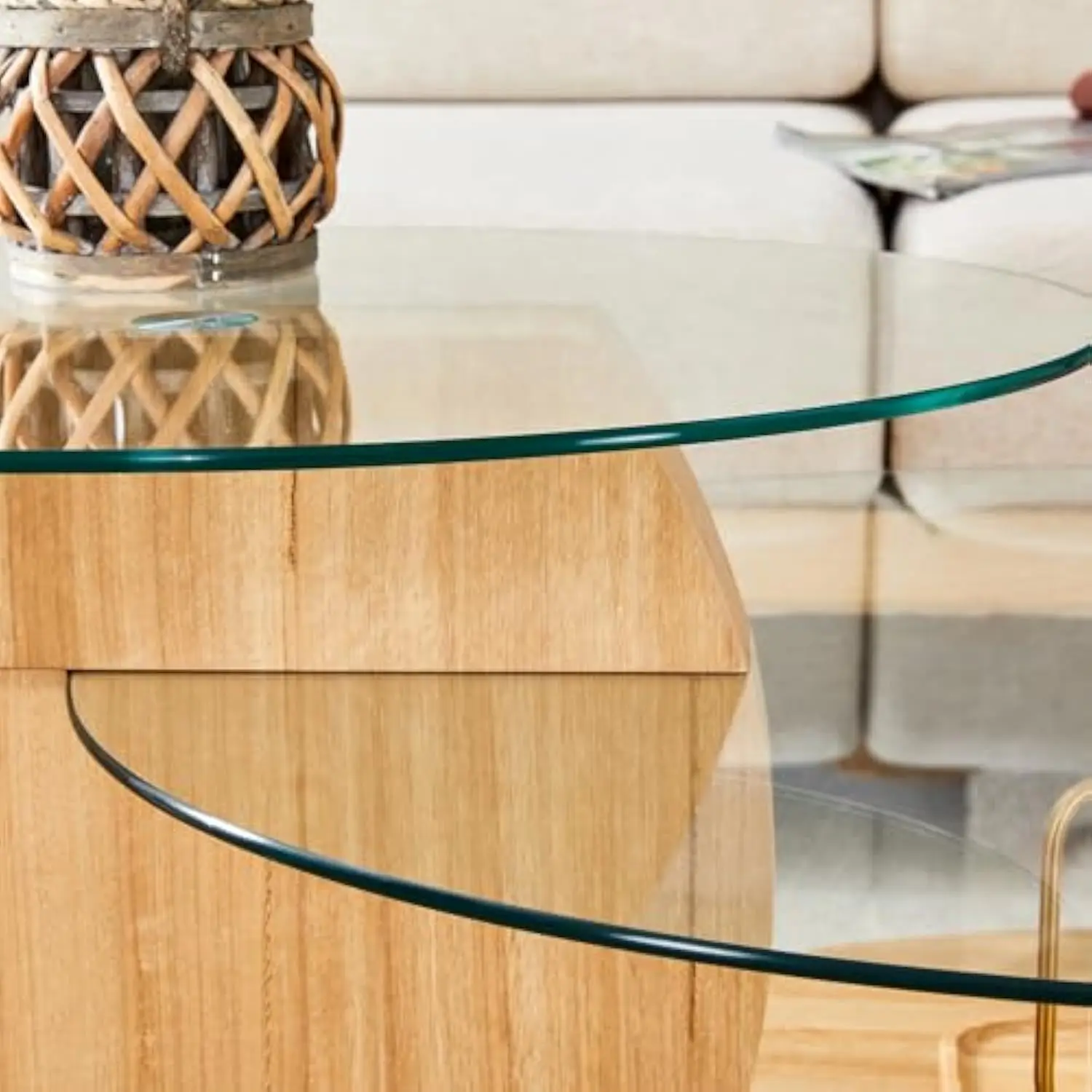
Materials Matter: Choosing and Caring for Your Round Mid-Century Table
The materials used in mid-century coffee tables significantly impact not only their appearance but also their durability, maintenance requirements, and overall character. Understanding these materials helps in both selection and proper care.
Wood Varieties and Their Characteristics
Authentic mid-century designs showcase several distinctive wood types:
Walnut: Perhaps the quintessential mid-century wood, walnut offers deep, rich brown tones that darken beautifully with age. Its straight grain occasionally features stunning figuring that creates natural artwork in furniture pieces. Walnut requires minimal maintenance beyond regular dusting and occasional polishing with appropriate wood care products.
Teak: Prized for its natural oils that provide water resistance and durability, teak develops a silvery patina over time unless regularly oiled. Its golden-brown color brings warmth to any space while offering exceptional longevity.
Oak: More commonly found in Scandinavian mid-century designs, oak provides excellent structural strength with a distinctive grain pattern. Its lighter tone creates a more casual, airy feel compared to darker woods.
Alternative Materials in Mid-Century Design
Beyond wood, authentic mid-century tables often incorporate complementary materials:
Glass: Mid-century modern glass top coffee tables combine wood or metal bases with tempered glass surfaces, creating visual lightness while offering a durable, easy-to-clean surface. Glass requires simple cleaning with standard glass cleaners and soft cloths.
Marble: Mid-century modern marble top coffee tables provide elegance and natural variation. Each piece features unique veining patterns that make it one-of-a-kind. However, marble requires more careful maintenance, including prompt cleaning of spills to prevent staining and the use of coasters to avoid etching from acidic beverages.
Laminates: More affordable mid-century pieces often utilized colorful laminates over plywood, creating bold geometric patterns or solid colors that defined the era’s playful side. These surfaces are extremely durable and easy to clean but lack the natural warmth of wood.
Care Guidelines for Longevity
To maintain the beauty of a mid-century coffee table:
- Dust regularly with a soft, slightly damp cloth
- Clean up spills immediately, especially on wood and marble surfaces
- Use coasters, placemats, and trivets to protect surfaces from moisture and heat
- Apply appropriate protective products (wood oils, marble sealants) as recommended for your specific material
- Position furniture away from direct sunlight to prevent fading and drying of wood
Material Selection Based on Lifestyle
When selecting materials, consider your household needs:
– Homes with young children might benefit from more durable surfaces like tempered glass
– Busy households might prefer woods with visible grain patterns that help disguise minor scratches
– Those seeking minimal maintenance might choose teak or laminate options
– Collectors and design enthusiasts might prioritize authentic materials typical of the period regardless of care requirements
Mid-Century Modern Solid Wood Coffee Tables, Mid-Century Modern Teak Coffee Tables
$879.95 Select options This product has multiple variants. The options may be chosen on the product pageMid-Century Modern Danish Coffee Tables, Mid-Century Modern Oval Coffee Tables, Mid-Century Modern Solid Wood Coffee Tables
$390.05 Select options This product has multiple variants. The options may be chosen on the product pageMid-Century Modern Glass Top Coffee Tables, Mid-Century Modern Glass Top Side & End Tables
$460.58 Select options This product has multiple variants. The options may be chosen on the product pageMid-Century Modern Glass Top Coffee Tables, Mid-Century Modern Vintage Coffee Tables, Mid-Century Modern Vintage Side & End Tables
$725.36 Select options This product has multiple variants. The options may be chosen on the product pageMid-Century Modern Marble Top Coffee Tables, Mid-Century Modern Rectangular Coffee Tables, Mid-Century Modern White Coffee Tables
Price range: $163.28 through $189.22 Select options This product has multiple variants. The options may be chosen on the product pageMid-Century Modern Oval Coffee Tables, Mid-Century Modern Solid Wood Coffee Tables
$679.56 Select options This product has multiple variants. The options may be chosen on the product page
Finding the Perfect Fit: Sizing and Placement Guidelines
Selecting the right size round coffee table is crucial for both aesthetics and functionality. Following these guidelines will help ensure your table fits harmoniously within your space.
Diameter Considerations
Round coffee tables typically range from 30 to 48 inches (76-122 cm) in diameter, with different sizes serving different purposes:
- Small (30-36 inches/76-91 cm): Ideal for apartments, smaller living rooms, or spaces with limited seating. Mid-century modern small coffee tables work particularly well in compact arrangements.
- Medium (36-42 inches/91-107 cm): The most versatile size, suitable for average living rooms with a standard three-seat sofa and perhaps one or two accent chairs.
- Large (42-48 inches/107-122 cm): Best for spacious living rooms with extended seating arrangements or sectional sofas.
Height Standards
The ideal coffee table height typically falls between 16 and 18 inches (40-45 cm), though this should be determined relative to your seating:
– The table surface should be approximately 1-2 inches (2.5-5 cm) below your sofa seat height for comfortable reach and proportion
– Lower profile mid-century sofas may pair better with tables on the shorter end of this range
Clearance Requirements
Proper spacing ensures comfortable movement around your table:
– Allow at least 18 inches (45 cm) between the edge of the table and seating for comfortable legroom
– Maintain minimum 24 inches (60 cm) between the table and other furniture to create comfortable pathways
– In smaller spaces, you can reduce this to 18 inches (45 cm) if necessary, though this creates tighter pathways
Proportion Rules
For visual harmony, follow these proportion guidelines:
– Choose a table diameter approximately two-thirds the length of your sofa
– Ensure the table doesn’t extend beyond the length of the sofa when placed centrally
– For L-shaped sectionals, center the table in the angle created by the two sections
Placement Principles
The position of your coffee table significantly impacts both flow and function:
– Center the table within the primary seating arrangement rather than the room itself
– Ensure all seated positions have easy access to the table surface
– In open concept spaces, use the table to help define and anchor the living area
– For asymmetrical furniture arrangements, position the table to balance visual weight
Complementary Furnishings: Creating a Cohesive Mid-Century Living Space
A round mid-century coffee table works best when surrounded by complementary furnishings that enhance its design impact while creating a cohesive overall aesthetic.
Seating Companions
The right seating choices can dramatically enhance the appeal of your round coffee table:
Sofas: Look for clean-lined options with tapered legs that echo your table’s design language. Mid-century sofas typically feature straight backs, minimal cushioning, and elevated profiles that reveal more floor space.
Lounge Chairs: Iconic mid-century chair designs like the Eames lounge chair, egg chair, or wishbone chair provide perfect companions to round coffee tables, offering organic curves that complement circular forms.
Accent Seating: Consider adding small stools or ottomans that can tuck partially under the table edge when not in use, providing flexible seating without cluttering the space.
Grounding with the Right Rug
A well-chosen area rug helps frame your coffee table and define the seating area:
- For round tables, both rectangular and round rugs work well, though rectangular options typically provide better coverage under all seating pieces
- Ensure the rug extends at least 18-24 inches (45-60 cm) beyond the edge of the table on all sides
- Look for geometric patterns, subtle textures, or solid colors that complement rather than compete with your table
Lighting Elements
Strategic lighting enhances both the function and appearance of your coffee table area:
- Arc floor lamps with marble bases offer quintessential mid-century style while providing overhead lighting for the table surface
- Table lamps on nearby consoles or side tables add layered lighting that highlights your coffee table display
- Consider the material relationships between lighting fixtures and your table—brass fixtures particularly complement walnut and teak
Complementary Side Tables
When selecting side tables to accompany your round coffee table:
- Look for pieces that share material or design elements with your coffee table
- Consider nesting tables for flexible surface options that maintain visual consistency
- Mix shapes thoughtfully—pairing round coffee tables with square or rectangular side tables often creates pleasing contrast
Style Integration
The versatility of mid-century design allows it to blend beautifully with many other styles. Styles go well mid-century modern include:
- Scandinavian minimalism for a light, airy aesthetic
- Industrial elements for edgier contrast
- Bohemian textiles and accessories for warmth and personality
- Contemporary pieces that share clean lines and simple forms
This flexibility makes round mid-century coffee tables particularly valuable in today’s eclectic interiors, where they can serve as a bridge between different design influences.
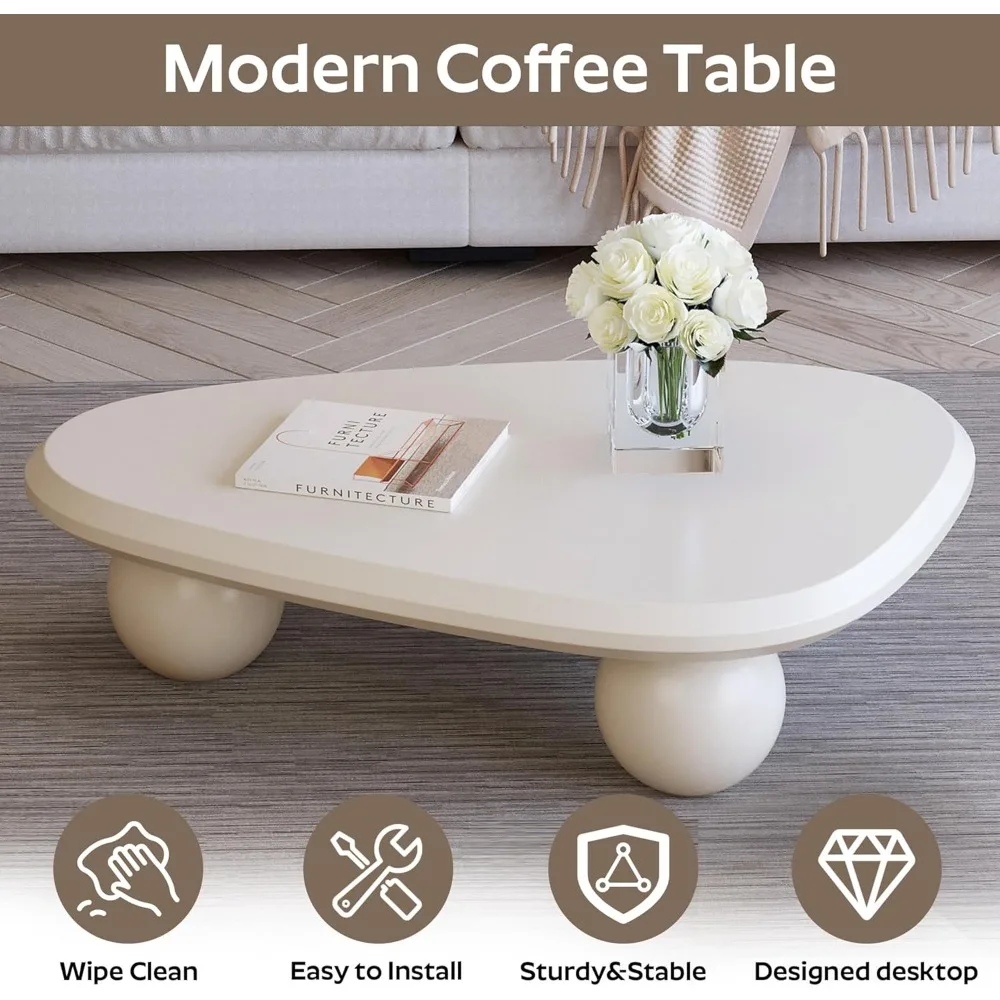
Is a Round Mid-Century Coffee Table Right for Your Space? Key Considerations
Before investing in a round mid-century coffee table, consider these factors to determine if it’s the optimal choice for your specific needs and space.
Space Assessment
Round tables excel in certain spaces but may not be ideal for all:
Ideal for round tables:
– Square rooms where the circular form provides pleasing contrast
– Tight spaces where the absence of corners improves flow
– Rooms with multiple entrance points requiring flexible navigation paths
– Areas where people need to move around the seating arrangement frequently
When rectangular might work better:
– Very narrow rooms where a round table might extend too far into pathways
– Spaces where you need to maximize surface area (rectangular tables typically provide more usable surface in the same footprint)
– When the table needs to align with specific architectural features
Lifestyle Factors
Your daily habits and household needs should influence your decision:
- Do you frequently entertain guests? Round tables facilitate more inclusive conversations.
- Do you have young children or elderly family members? Round tables eliminate hazardous corners.
- Do you use your coffee table primarily for dining, working, or games? Consider how the circular shape impacts these activities.
- How much surface area do you realistically need for your typical coffee table uses?
Design Compatibility
Consider how a round table will interact with your existing furnishings:
- Rooms with predominantly angular furniture benefit from the softening effect of curved pieces
- Spaces that already feature many curved elements might become more balanced with rectangular tables
- Consider how the negative space created by a round table works within your specific floor plan
For those weighing options, understanding the differences between round oval mid-century coffee tables can help you make an informed decision based on your space constraints and aesthetic preferences.
Where to Place Your Round Mid-Century Coffee Table: Beyond the Living Room
While coffee tables naturally belong in living rooms, round mid-century tables are versatile enough to serve multiple purposes throughout the home.
Entryway Statement
In larger foyers or entrance halls, a round mid-century coffee table can function as a striking center table. Placed beneath a pendant light or chandelier, it creates a welcoming focal point while providing a surface for keys, mail, and decorative elements. The round shape allows for easy navigation around the table in a high-traffic area.
Office Centerpiece
In a home office with a seating area, a round coffee table creates an ideal spot for informal meetings or a change of scenery during the workday. The circular form encourages collaboration and conversation, making it perfect for creative discussions or client meetings in a more relaxed setting.
Bedroom Retreat
In spacious master bedrooms, a small to medium round coffee table can create a charming seating area when paired with a loveseat or a couple of comfortable chairs. This arrangement provides a private space for morning coffee, reading, or conversation that feels separate from the sleeping area.
Multi-Purpose Dining
In compact apartments or studios, a slightly taller round mid-century table (18-22 inches/45-56 cm) can serve double duty as both coffee table and casual dining surface. Pair with floor cushions, poufs, or low stools for a flexible eating arrangement that doesn’t require a dedicated dining space.
Creative Room Divider
In open-concept spaces, a round coffee table with seating arranged around it can help define distinct functional areas without creating visual barriers. The circular arrangement naturally creates a sense of a separate “room” within the larger space.
When considering alternative placements, explore different ways of decorating black mid-century coffee tables and other finishes to suit various rooms and functions throughout your home.
The beauty of round mid-century coffee tables lies not just in their iconic design but in their remarkable versatility and ability to enhance nearly any space with their timeless charm and practical benefits.

